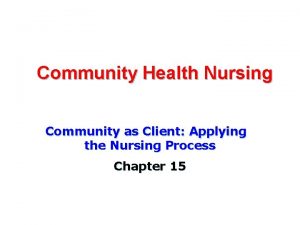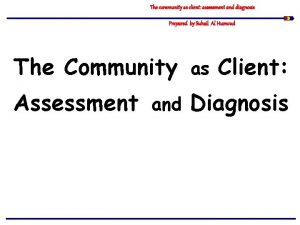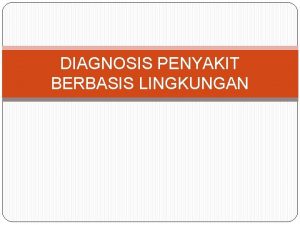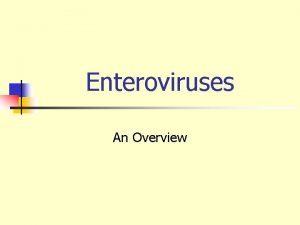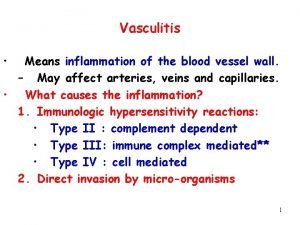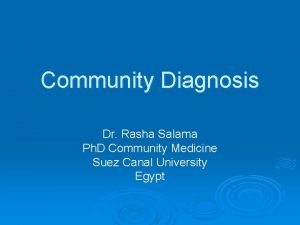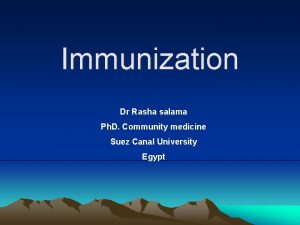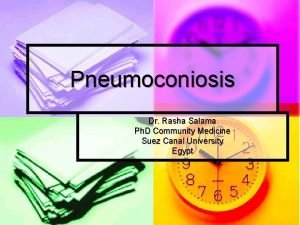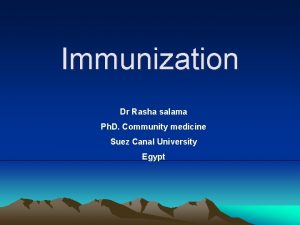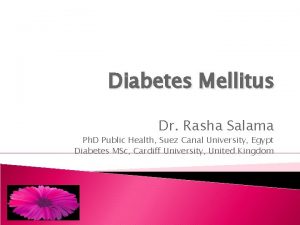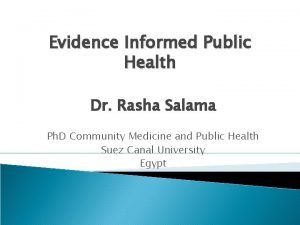Community Diagnosis Dr Rasha Salama Ph D Community



























- Slides: 27

Community Diagnosis Dr. Rasha Salama Ph. D Community Medicine Suez Canal University Egypt

Definition of a “Community” Ø A cluster of people with at least one common characteristic (geographic location, occupation, ethnicity, housing condition……) Ø A group of people with a common characteristic or interest living together within a larger society

Community Ø A community is a whole entity that functions because of the interdependence of its parts or subsystems. Eight subsystems plus the community core are identified.

Community Core 1. Community core: history, socio-demographic characteristics, vital statistics, values/beliefs/religions. core

Eight Subsystems 2. Eight subsystems: • • Physical environment Education Safety and transportation Politics and government Health and social services Communication Economics recreation

Definition of Community Diagnosis Ø Community diagnosis generally refers to the identification and quantification of health problems in a community as a whole in terms of mortality and morbidity rates and ratios, and identification of their correlates for the purpose of defining those at risk or those in need of health care.

The Community Diagnosis Process Ø “A means of examining aggregate and social statistics in addition to the knowledge of the local situation, in order to determine the health needs of the community”

Goal Ø The mission of community diagnosis is to: l l l Analyze the health status of the community Evaluate the health resources, services, and systems of care within the community Assess attitudes toward community health services and issues Identify priorities, establish goals, and determine courses of action to improve the health status of the community Establish an epidemiologic baseline for measuring improvement over time.

ØHow is the community diagnosed?

Community Analysis Ø Community analysis is the process of examining data to define needs strengths, barriers, opportunities, readiness, and resources. The product of analysis is the “community profile”.

Community Analysis (cont. ) Ø To analyze assessment data is helpful to categorize the data. This may be done as following: l l l Demographic Environmental Socioeconomic Health resources and services Health policies Study of target groups.

Ø Community is diagnosed using: Health Indicators

Indicators of health are variables used for the assessment of community health.

Characteristics of Indicators: Ø a. should be valid, i. e. , they should actually measure what they are supposed to measure; Ø b. should be reliable and objective, i. e. , the answers should be the same if measured by different people in similar circumstances; Ø c. should be sensitive, i. e. , they should be sensitive to changes in the situation concerned, Ø d. should be specific, i. e. , they should reflect changes only in the situation concerned, Ø e. should be feasible, i. e. , they should have the ability to obtain data needed, and; Ø f. should be relevant, i. e. , they should contribute to the understanding of the phenomenon of interest.

Classification of health Indicators Ø Ø Ø Mortality indicators Morbidity indicators Disability rates Nutritional status indicators Health care delivery indicators Utilization rates Ø Ø Ø Indicators of social and mental health Environmental indicators Socio-economic indicators Health policy indicators Indicators of quality of life Other indicators

Mortality Indicators Ø Mortality Rates - The traditional measures of health status. Widely used because of their ready availability. ( death certificate is a legal requirement in many countries) - Ø Ø Ø Ø Crude death rates Specific death rates: age/disease Expectation of life Infant mortality rate Maternal mortality rate Proportionate mortality ratio Case Fatality rate

Morbidity Indicators Ø Morbidity rates - Data on morbidity are preferable, although often difficult to obtain. Incidence and prevalence Ø Notification rates Ø Attendance rates: outpatient clinics or health centers. Ø Admission and discharge rates Ø Hospital stay duration rates Ø

Disability Indicators Ø Disability rates Ø Ø No. of days of restricted activity Bed disability days Work/School loss days within a specified period. Expectation of life free of disability

Nutritional Indicators Ø Nutritional Status Indicators - It is an indicator of positive health Anthropometrics measurements Ø Height of children at school entry Ø Prevalence of low birth weight Ø Clinical surveys: Anaemia, Hypothyroidism, Nightblindness Ø

Health Care Delivery Indicators Ø - Reflect the Equity / Provision of health care Ø Ø Ø Doctor / Population ratio Doctor / Nurse ratio Population / Bed ratio Population / per health center

Utilization Indicators Ø Health care utilization Rates - Extent of use of health services - Proportion of people in need of service who actually receive it in a given period Proportion of infants who are fully immunized in the 1 st year of life. i. e. . immunization coverage. Ø Proportion of pregnant women who receive ANC. Ø Hospital-Beds occupancy rate. Ø Hospital-Beds turn-over ratio Ø

Social/Mental Health Indicators Ø Indicators of Social and Mental Health - Valid positive indicators does not often exist - Indirect measures are commonly used Suicide & Homicide rates Ø Road traffic accidents Ø Alcohol and drug abuse. Ø

Environmental Indicators Ø Environmental health Indicators - Reflect the quality of environment Measures of Pollution Ø The proportion of people having access to safe water and sanitation facilities Ø Vectors density Ø

Socio-economic Indicators Ø - Is not a direct measure of health status. - For interpretation of health care indicators. Ø Ø Ø Rate of population increase Per capita GNP Level of unemployment Literacy rates - females Family size Housing condition e. g. No. of persons per room

Health Policy Indicators Ø Health Policy Indicators - Allocation of adequate resources. Proportion of GNP spent on health services. Ø Proportion of GNP spent on health related activities. Ø Proportion of total health resources devoted to primary health care Ø

Other Indicators Ø Other health indicators Indicators of quality of life. Ø Basic needs indicators. Ø Health for all indicators. Ø

Thank You
 Rasha salama
Rasha salama Alpha particle diagram
Alpha particle diagram Rasha salama
Rasha salama Public communication campaigns
Public communication campaigns Rasha salama
Rasha salama Salama taktika
Salama taktika Merimde beni salama
Merimde beni salama Paul salama
Paul salama Medical diagnosis and nursing diagnosis difference
Medical diagnosis and nursing diagnosis difference Nursing process and critical thinking
Nursing process and critical thinking Purpose of nursing process
Purpose of nursing process Perbedaan diagnosis gizi dan diagnosis medis
Perbedaan diagnosis gizi dan diagnosis medis Medical diagnosis and nursing diagnosis difference
Medical diagnosis and nursing diagnosis difference This is the blue print of the nursing process.
This is the blue print of the nursing process. Community diagnosis
Community diagnosis Nursing process introduction
Nursing process introduction Subjective vs objective nursing
Subjective vs objective nursing Community as client
Community as client Purpose of community diagnosis
Purpose of community diagnosis Community action cycle
Community action cycle Megaloblastic anemia causes
Megaloblastic anemia causes Test for syphilis
Test for syphilis Asthma diagnosis criteria
Asthma diagnosis criteria What does drum brake diagnosis start with?
What does drum brake diagnosis start with? Langkah diagnosis komunitas
Langkah diagnosis komunitas Poliovirus lab diagnosis
Poliovirus lab diagnosis Hilda taba model of curriculum development
Hilda taba model of curriculum development Vasculitis
Vasculitis

















